The Kedarnath Wildlife Sanctuary is one of the largest protected areas in Uttarakhand, India.
It is named after the Kedarnath Temple, a key Hindu pilgrimage site. Established in 1972, it is known for its diverse wildlife and beautiful landscapes, playing an important role in protecting the Himalayan ecosystem.
The sanctuary is also part of the Protected Areas Network along the Ganga River, helping to preserve the Ganga’s freshwater ecosystem. Everything you need to know about this remarkable sanctuary—from its wildlife and terrain to conservation efforts and travel tips—is covered in this detailed guide.
Table of Contents
History of Kedarnath Wildlife Sanctuary
Kedarnath Wildlife Sanctuary, also known as Kedarnath Musk Deer Sanctuary, is one of the largest protected areas in Uttarakhand, India.
The region is home to the famous Kedarnath Temple, one of the twelve Jyotirlingas of Lord Shiva. For centuries, pilgrims have visited this sacred temple, and the surrounding forests and mountains have long been considered holy. These religious ties helped draw attention to the need for environmental protection in the region.

The primary purpose of the sanctuary is to protect the endangered Himalayan musk deer, which is why it is also called the Kedarnath Musk Deer Sanctuary. This sanctuary is rich in biodiversity, with over 1,100 plant species, as well as a variety of animal species, such as snow leopards, Himalayan black bears, and various bird species.
Additionally, the sanctuary has faced some major calamities, particularly the 2013 floods that caused destruction in Kedarnath. Today, Kedarnath Wildlife Sanctuary stands as a model for combining conservation, cultural heritage, and ecotourism.
Geography and Location
This 975 square kilometer sanctuary, which is spread throughout the districts of Rudraprayag and Chamoli in Uttarakhand, is a beautiful yet harsh terrain where altitude determines everything from weather patterns to the kinds of animals that may be found here. Due to this extreme variation in elevation and climate, Kedarnath wildlife sanctuary is unique, where survival demands adaptation, and every season brings a new view to the landscape.
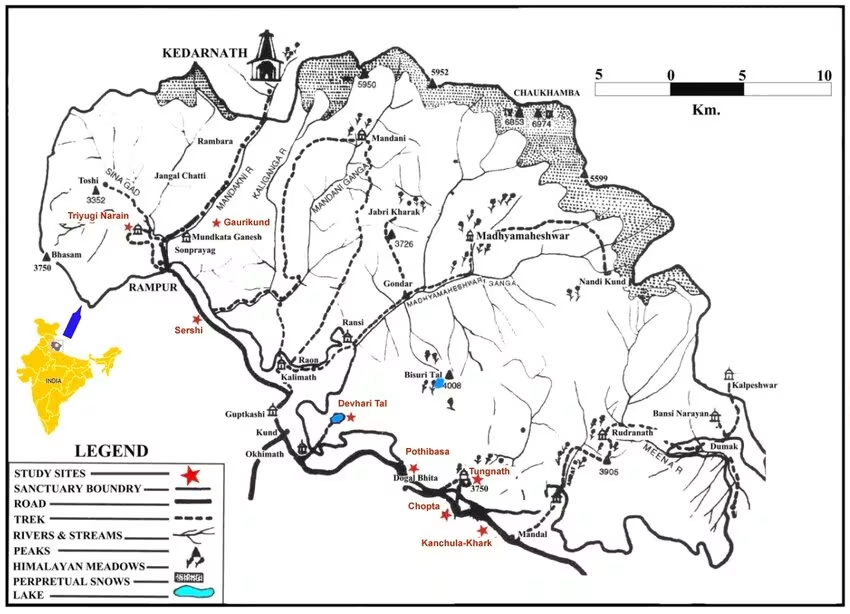
Geographical Features
- Elevation Range: The sanctuary’s altitude varies, from 1,160 meters (3,800 feet) near Phata to 7,068 meters (23,189 feet) at Chaukhamba, the highest peak in the region.
- Mountain Peaks: Apart from Chaukhamba, other famous peaks include Swet Parvat, Sumeru Parbat and Mandani Parbat.
Rivers & Water Bodies
- The Mandakini River, a major tributary of the Alaknanda, flows through the sanctuary.
- The Alaknanda River also passes nearby, contributing to the rich aquatic ecosystem.
- Several glacial lakes and streams are found at higher altitudes, which are formed due to the melting snow.
- Glaciers & Valleys: The sanctuary has glacial valleys like Chorabari Bamak, which contribute to the Mandakini River. The rugged terrain includes deep valleys, bugyals, and dense forests.
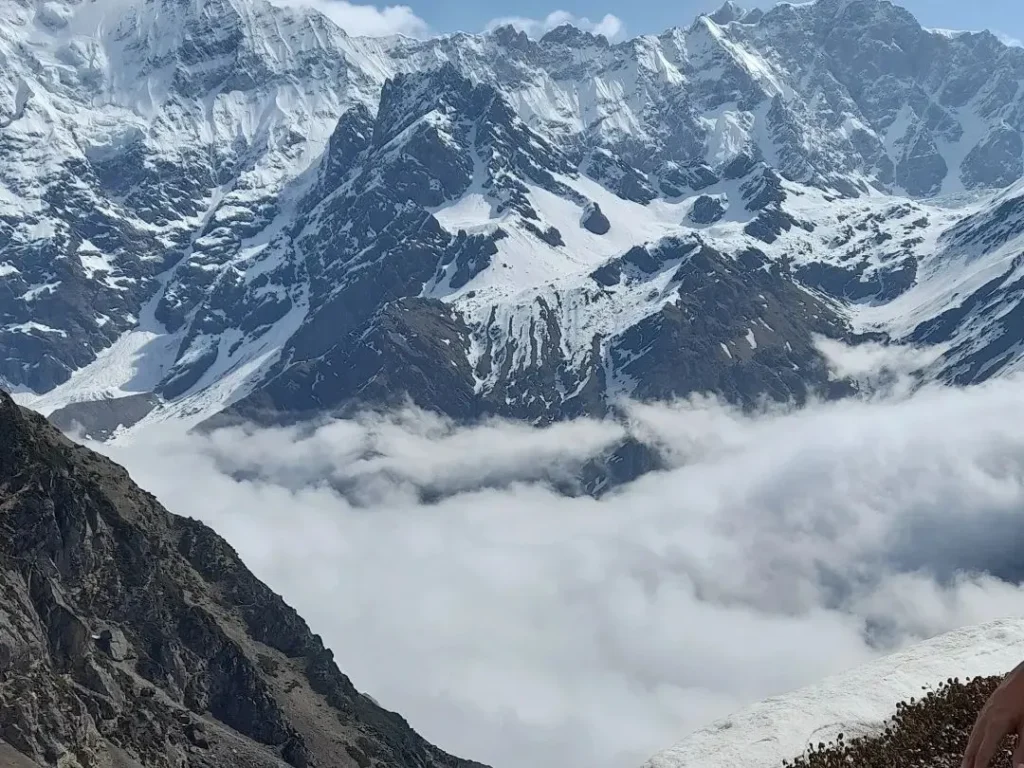
Climate Zones
Due to its vast elevation range, the sanctuary experiences three distinct climate zones:
1. Subtropical (1,000–2,000 m)
- Temperature: 15°C to 30°C in summer; mild winters.
- Rainfall: Heavy during monsoon (July–September).
- Vegetation: Dense forests of Sal, Banj Oak, and Rhododendron.
2. Temperate (2,000–3,000 m)
- Temperature: Cool summers (10°C–20°C); cold winters (often below 0°C).
- Snowfall: Occasional in winter.
- Vegetation: Coniferous forests (Deodar, Blue Pine, Spruce) and a variety of flowers.
3. Alpine (Above 3,000 m)
- Temperature: Harsh winters (below -10°C); short, cool summers.
- Snow Cover: Remains snow-covered for months.
- Vegetation: Small shrubs, grasses, and rare medicinal herbs like Brahma Kamal.

Seasonal Variations
- Summer (April–June): Best for tourism—sunny days, cool nights. Ideal for trekking and wildlife spotting.
- Monsoon (July–September): Heavy rainfall causes landslides; many routes become risky.
- Winter (October–March): Extreme cold with heavy snowfall; higher zones are restricted.
The sanctuary’s diverse geography and climate make it a unique habitat for rare Himalayan species. Its glacial rivers, snow-capped peaks, and valleys create an ecosystem that requires careful conservation.
Flora Of Kedarnath Wildlife Sanctuary
The Kedarnath Wildlife Sanctuary constitutes a diverse variety of plant life, with vegetation changing as the altitude rises from subtropical forests to grassy pastures. This ecosystem is shaped by the sanctuary’s wide elevation range (1,160–7,068 m), creating different ecological zones where different plants grow.
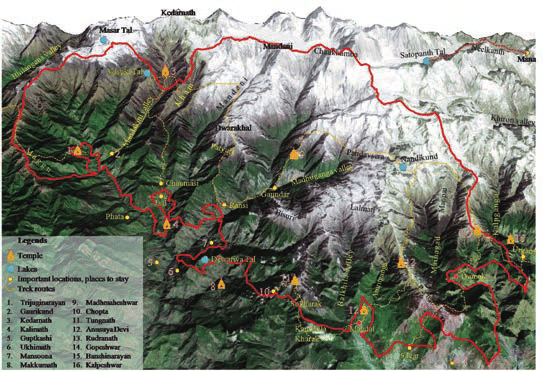
1. Subtropical Zone (1,000–2,000 m)
The lower hills have dense subtropical forests that are dominated by:
- Banj Oak (Quercus leucotrichophora): An evergreen tree with a rounded canopy
- Rhododendron (Rhododendron arboreum): Also known as Buransh or Gurans in local languages, it blooms with red flowers in spring. These flowers are also used to make juice, known as buransh ka juice.
- Sal (Shorea robusta): Found near river valleys
This zone also contains medicinal plants like Indian Valerian and Himalayan Nettle, while the forest floor blooms with wild strawberries, ferns, and orchids during monsoon.
2. Temperate Zone (2,000–3,000 m): Conifer Country
As elevation increases, the vegetation of forests changes to:
- Deodar Cedar (Cedrus deodara): Large trunks with aromatic wood
- Blue Pine (Pinus wallichiana): A Coniferous tree that can be recognized by its long, needle-like leaves
- West Himalayan Spruce (Picea smithiana): Another evergreen tree that has drooping branches
- Wild Raspberries and Currants
- Himalayan Mayapple (Podophyllum hexandrum): A rare medicinal herb
- Brahma Kamal (Saussurea obvallata): Uttarakhand’s sacred state flower that blooms at night
3. Alpine Zone (3,000 m+): Nature’s Hardiest Survivors
As the altitude increases, the vegetation decreases:
- Dwarf Rhododendrons that grow around 1-3 feet. Remeber, these are not the same as regular Rhododendrons.
- Medicinal herbs, including Aconitum (monkshood) and Rheum (Himalayan rhubarb)
- Small grass that feeds mountain herbivores
The sanctuary’s flora plays an important role—preventing soil erosion, regulating water flow to the Ganga basin, and providing food/shelter for wildlife. Many plants like the Brahma Kamal have cultural significance, featuring in local legends and traditional medicine. This rich ecosystem makes Kedarnath a living laboratory for studying Himalayan plant adaptations.
Fauna (Wildlife) of Kedarnath Wildlife Sanctuary
A wide range of wildlife, including pheasants and the snow leopard, can be seen at Kedarnath Wildlife Sanctuary. More than 200 animal species, including 75 birds and 15 mammals, have been listed under India’s Wildlife Protection Act, and they live in this 975 sq km protected region. The sanctuary’s location between the western and eastern Himalayan ecosystems provides a rare mixing ground for species from both regions.
Mammals

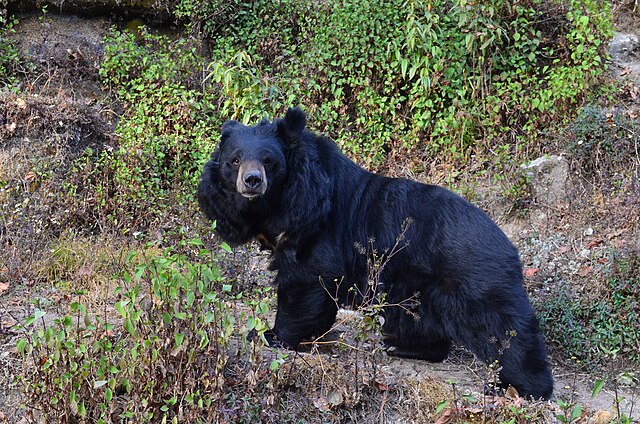
1. Big Cats & Predators:
- Snow Leopard (Panthera uncia): The sanctuary’s most iconic yet rarely seen animal. The snow leopards live in high-altitude regions above 3,500m, and their thick gray-white fur serves as the perfect coat for camouflage in snowy areas.
- Himalayan Black Bear (Ursus thibetanus): These black-coated omnivores live in oak forests (2,000-3,000m). They are often seen standing on their hind legs to reach fruits.
- Common Leopard (Panthera pardus): More frequently spotted than snow leopards, they are found in middle altitudes and sometimes near villages looking for prey.
2. Mountain Ungulates:
- Himalayan Musk Deer (Moschus chrysogaster): This endangered species, recognized by its fang-like teeth or tusks, can be found in dense rhododendron forests. A unique feature about them is that the male musk deer secretes a prized musk smell, making them a poaching target.
- Himalayan Tahr (Hemitragus jemlahicus): These goat-like antelopes with curved horns cling to steep cliffs and can be seen in herds of 10-15. They have a thick reddish coat that sheds in summer.
- Serow (Capricornis sumatraensis): another goat-like or antelope-like mammal with dark hair and short horns found in forests.
3. Other Notable Mammals:
- Red Fox (Vulpes vulpes): These rusty-colored mammals follow trekking trails, looking for food near campsites.
- Himalayan Marten (Martes flavigula): These yellow-throated weasel-like predators hunt birds and rodents in conifer forests.
- Langurs & Macaques: Groups of Gray Langurs (Semnopithecus schistaceus) and Rhesus Macaques (Macaca mulatta) can be found in the lower forests and temple areas.
Birds
The sanctuary is a paradise for birdwatchers, with species ranging from high-altitude predators to migratory visitors:
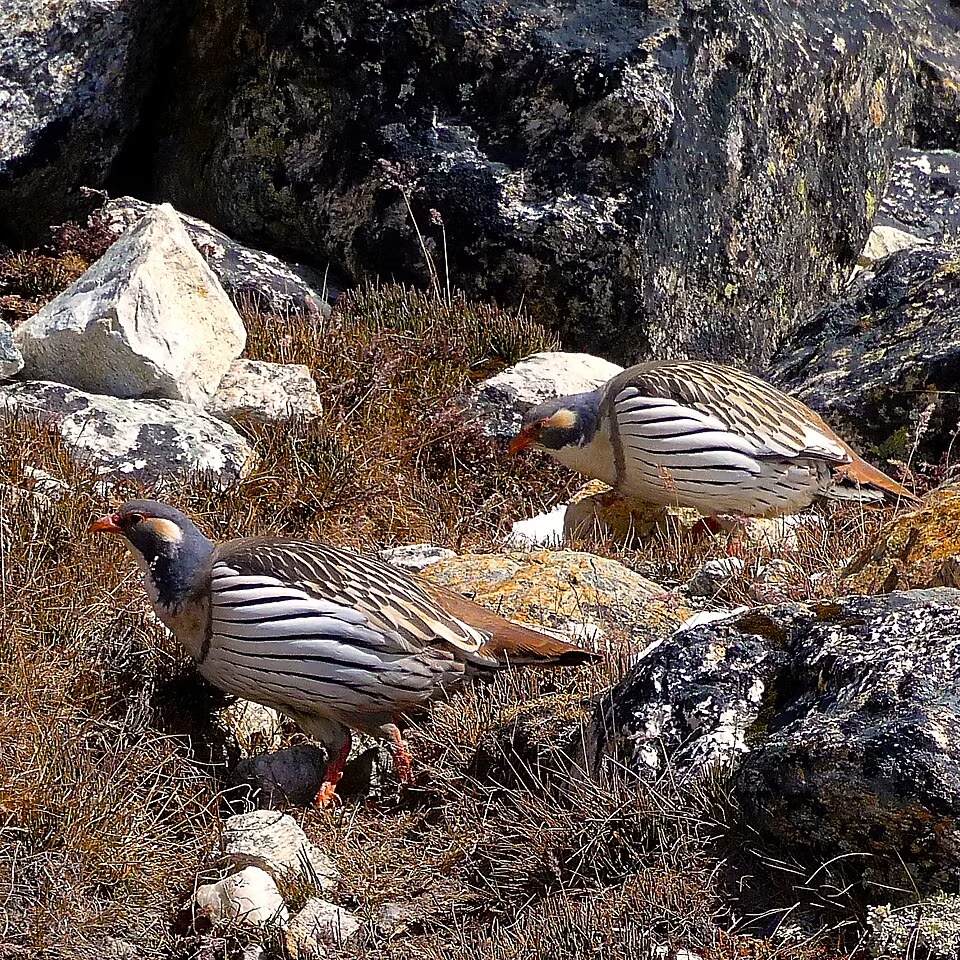
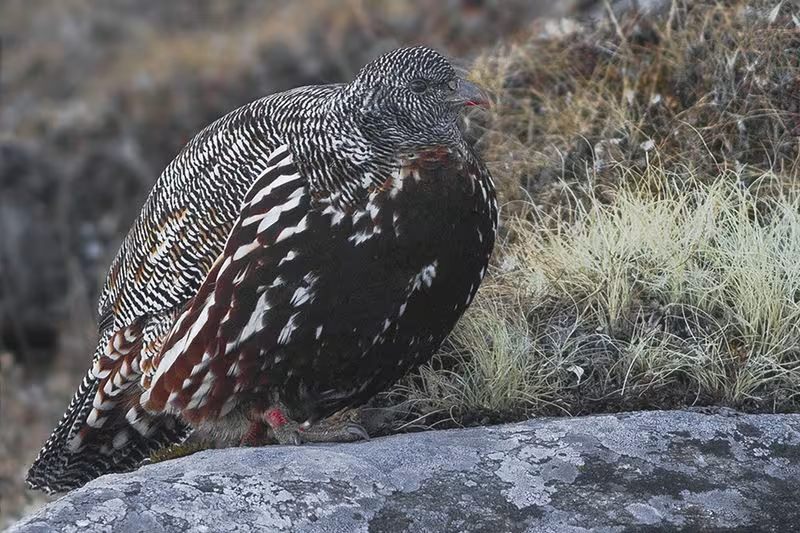
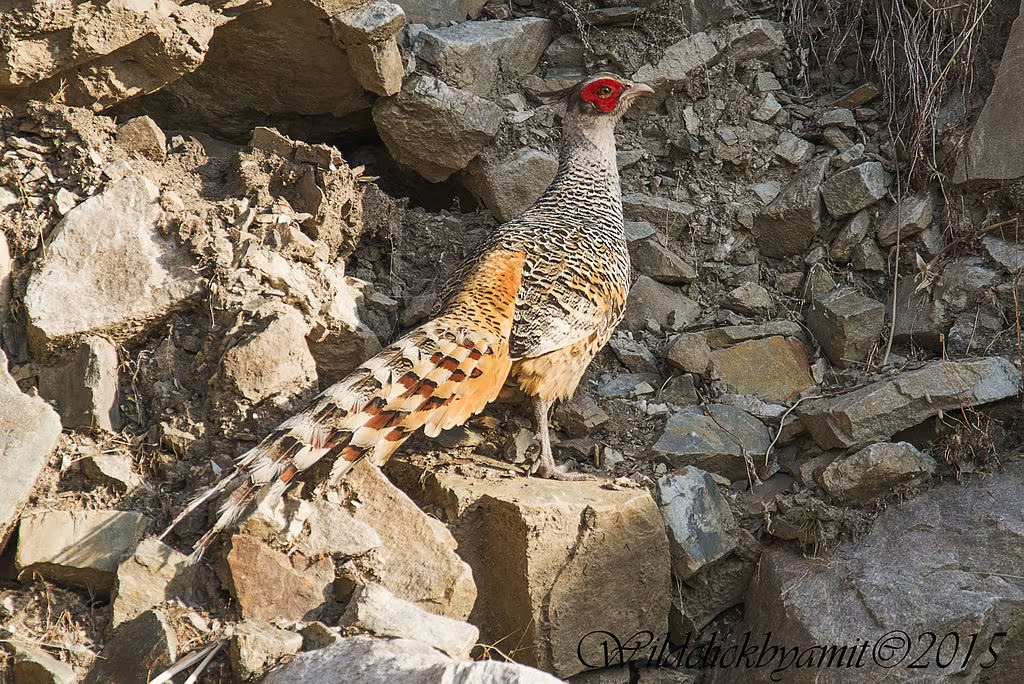
1. Pheasants & Ground Birds:
- Himalayan Monal (Lophophorus impejanus): Uttarakhand’s state bird with shiny blue and green feathers.
- Koklass Pheasant (Pucrasia macrolopha): Shy birds with a long black crest.
2. Birds of Prey:
- Golden Eagle (Aquila chrysaetos): With 2m wingspans, they soar above valleys, hunting for rodents and hares.
- Bearded Vulture (Gypaetus barbatus): These vultures are known to drop bones from heights to break them and eat the bone marrow.
3. Migratory & Seasonal Visitors:
- Snow Pigeons (Columba leuconota): Snow pigeons can be seen in flocks of 50+ on grainy fields.
- Himalayan Rubythroat (Calliope pectoralis): A vibrant red-throated songbird found in shrubby areas.
Reptiles & Amphibians: Cold-Adapted Survivors
- While less diverse than warm lowlands, these species demonstrate remarkable adaptations:
- Himalayan Pit Viper (Gloydius himalayanus): A venomous snake camouflaged among rocks up to 3,000m.
- Himalayan Newt (Tylototriton verrucosus): Found in chilly mountain streams, identifiable by orange markings.
Conservation Challenges
Several species face threats:
- Musk Deer: Poached for the perfume industry
- Snow Leopards: With only ~500 left in India
- Climate Change: High mountain species like pikas are losing habitat as temperatures rise
Major Attractions In Kedarnath Wildlife Sanctuary
Kedarnath Wildlife Sanctuary is a place of great spiritual importance and natural beauty, in addition to its amazing biodiversity. For pilgrims, hikers, and nature enthusiasts, the sanctuary provides life-changing experiences, from historic temples to snow-capped peaks.
1. Kedarnath Temple

Situated at 3,583 meters (11,755 ft) in the middle of the sanctuary’s harsh terrain, the Kedarnath Temple is one of Hinduism’s most sacred Jyotirlingas and part of the Char Dham Yatra. It is believed to have been built by the Pandavas and later restored by Adi Shankaracharya in the 8th century.
2. Vasuki Tal
At 4,135 meters (13,566 ft), this crescent-shaped glacial lake is named after Vasuki, the serpent king of Hindu mythology. Formed by the Chorabari Glacier, its waters change from turquoise to deep blue throughout the day.
3. Madhyamaheshwar
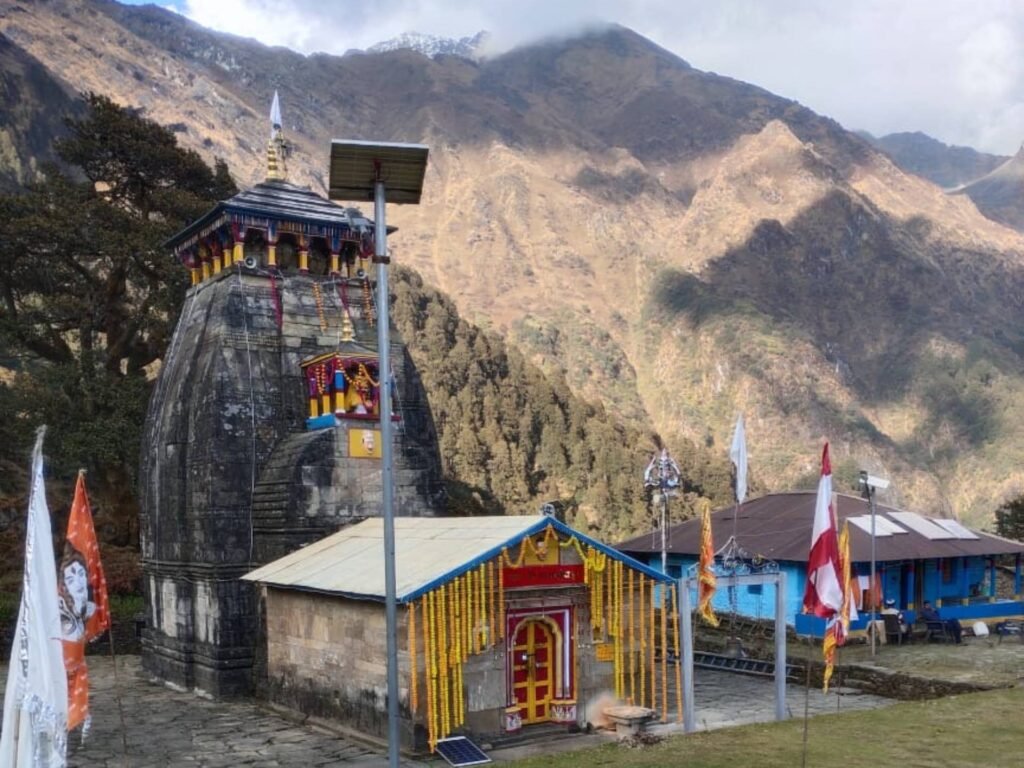
At 3,497 meters (11,473 ft), this lesser-visited Panch Kedar temple lies deep in the sanctuary’s eastern valleys. The 25 km trek from Uniana passes through:
- Bantoli: The 100-foot-tall Madhyamaheshwar Ganga waterfall.
- Gaundar: The last village before the high mountain zone, with stone-roofed homes.
4. Kalimath: The Sacred Seat of Goddess Kali
Located at 1,800 meters (5,905 ft) in Uttarakhand’s Rudraprayag district, Kalimath is among the 51 Shakti Peethas dedicated to the Goddess Kali. It’s believed that after killing the demon Raktabija, Goddess Kali disappeared into the earth at this very site. Unlike other temples, Kali is worshipped here in a symbolic form under a silver plate; no idol is present.
5. Rudranath
At 3,600 meters (11,811 ft), Rudranath is the third temple in the Panch Kedar, where Lord Shiva’s face is worshipped. Surrounded by dense forests and meadows, it offers a beautiful experience to the visitors. It is a remote trek reached by a 20 km trek from Sagar village (8–10 hrs) that passes through scenic spots like Panar and Pitradhar.
6. Tungnath
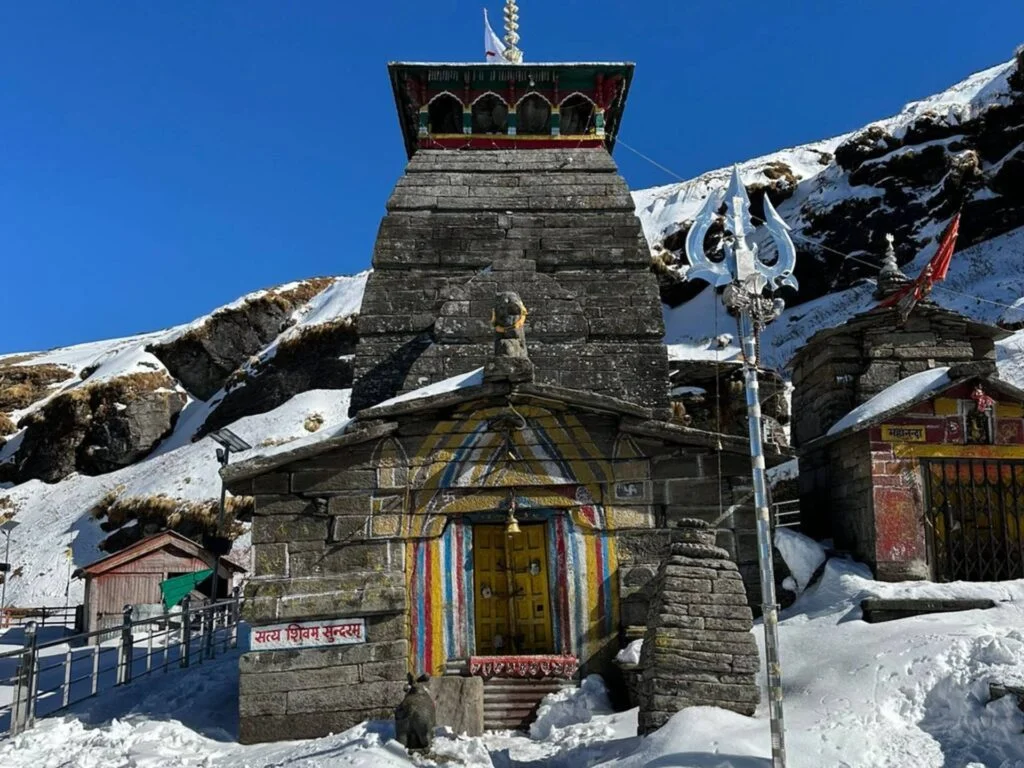
At 3,680 meters (12,073 ft), Tungnath is the highest of the Panch Kedar temples, believed to mark the site where Lord Shiva’s arms emerged. Located in the Garhwal Himalayas, it offers amazing views and high spiritual energy.
7. Bansi Narayan Temple
At approximately 3,600 meters (11,811 ft), the Bansi Narayan Temple is a remote stone shrine dedicated to Lord Vishnu, nestled in the Garhwal Himalayas of Uttarakhand. It opens only once a year during Raksha Bandhan.
How to Reach Kedarnath Wildlife Sanctuary
Reaching the Kedarnath Wildlife Sanctuary requires careful planning due to its remote Himalayan location and seasonal accessibility. The sanctuary is accessible via road, rail, and air, with the final destination involving treks or helicopter rides. Here’s a detailed guide to help you plan your journey:

1. By Air: Nearest Airport (Jolly Grant, Dehradun)
Distance to Sanctuary Entry Point (Sonprayag/Gaurikund): ~220 km (7-8 hrs drive)
Helicopter Option:
- Phata/Sersi to Kedarnath
Tip: Flights to Dehradun fill quickly during pilgrimage season (May–June). Book 2–3 months in advance.
2. By Train: Nearest Railway Station (Rishikesh/Haridwar)
Rishikesh (200 km from Sonprayag):
- Trains from Delhi: Nanda Devi Express (6 hrs), Shatabdi (4.5 hrs)
- Taxi/Bus: Shared jeeps or private cabs to Sonprayag
Haridwar (230 km):
- Connects to major cities like Mumbai and Kolkata via trains
- Nighttime is recommended before the onward journey
Note: There are no direct trains beyond Rishikesh. Road travel is mandatory.
3. By Road: Scenic but Challenging Drives
Route 1 (Delhi to Kedarnath Base):
Delhi → Haridwar (6 hrs approx.) → Rudraprayag (7 hrs approx.) → Sonprayag (2 hrs approx) → Gaurikund (Last Motorable Point)
Route 2 (Dehradun to Kedarnath):
Dehradun → Devprayag → Srinagar → Rudraprayag → Sonprayag
Key Stops:
- Rudraprayag: Convergence of Alaknanda & Mandakini rivers
- Guptkashi: Permits/registrations for Kedarnath pilgrims
- Sonprayag: Mandatory switch to shared jeeps for the final 5 km to Gaurikund
Travel Tips:
- Best Vehicles: SUVs/4x4s (steep, narrow roads)
- Avoid Night Driving: Landslide-prone areas
- Monsoon (July–Sept): Roads may close temporarily
4. Final Stretch: Trekking to Kedarnath
- Gaurikund to Kedarnath Temple: 16 km trek (6–8 hrs)
- Route: Rambara → Linchauli → Kedarnath
Options:
- Pony/Palki: ₹3,000–5,000 (book at Gaurikund)
- Helicopter: Phata/Sersi to Kedarnath (10 min)
For Sanctuary Exploration:
- Guided Treks: Required for areas like Vasuki Tal (forest permit from the Sonprayag office)
- Entry Gates: Sonprayag (main), Ukhimath (eastern side)
Pro Tip: Carry cash (ATMs scarce beyond Rudraprayag)
Whether you choose the spiritual journey on foot or a quicker by-air route, reaching Kedarnath is an adventure that offers unmatched Himalayan biodiversity and wildlife encounters.
Essential Tips for Visiting Kedarnath Wildlife Sanctuary
A trip to Kedarnath Wildlife Sanctuary is full of adventure but becomes demanding due to its high-altitude terrain, unpredictable weather, and remote location. Here’s a detailed guide to ensure a safe, responsible, and fulfilling experience:
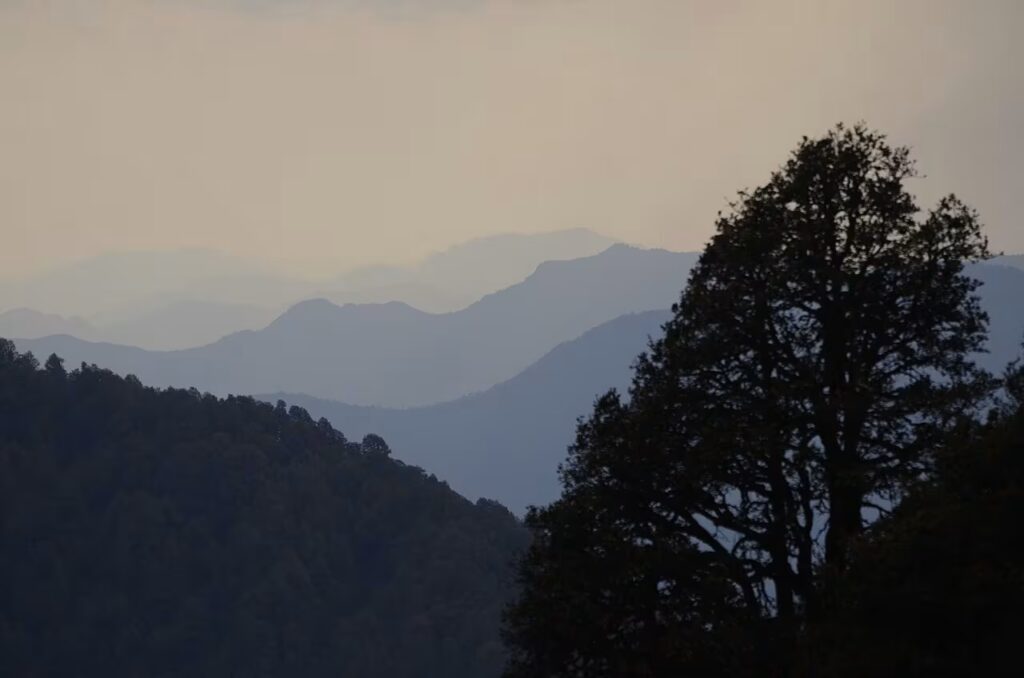
1. Getting Used to the Environment & Health Precautions
Gradual Ascent: Spend a night in Rudraprayag or Guptkashi (1,300–1,500m) before climbing to Kedarnath (3,583m) to avoid altitude sickness.
- Medications: Carry painkillers, ORS, and a basic first-aid kit.
- Oxygen: Portable oxygen canisters (available in Phata/Sonprayag) help in emergencies.
- Warning: Those with heart/lung conditions should consult doctors before traveling.
2. Packing Essentials
Clothing:
- Layered woolen clothes (nights drop below 0°C even in summer)
- Waterproof jacket (sudden rain/snow)
- Trekking shoes with grip (rocky, slippery trails)
Gear:
- Sunglasses (UV protection at high altitudes)
- Headlamp (power cuts are common)
- Reusable water bottle
Documents:
- ID proof (required for permits)
- Pilgrim registration slip (for Kedarnath Temple)
3. Permits & Regulations
Sanctuary Entry: Obtain permits from the Forest Office in Sonprayag (₹150 for Indian nationals and ₹600 for foreigners).
Trekking Restrictions:
- Vasuki Tal/Chorabari Glacier: A guide is required.
- Drones: Banned without prior permission.
Temple Rules:
- Non-Hindus can enter Kedarnath but not the inner sanctum.
- Photography is prohibited inside the temple
4. Wildlife & Safety
Animal Encounters:
- Maintain a 50m distance from bears/musk deer.
- Store food securely to avoid attracting langurs.
Trekking Safely:
- Start early (aim to finish by 3 PM before the weather worsens).
- Hire local guides for offbeat trails.
5. Responsible Tourism Practices
- Waste Management: Carry your trash back and throw it into the nearest dustbin.
- Water Conservation: Use bio-toilets; rivers are considered sacred.
Cultural Respect:
- Dress modestly (covered shoulders/knees at temples).
- Avoid loud noises in meditation zones.
6. Seasonal Considerations
- Summer (May–June): Crowded but best for Trekking. Book lodges in advance.
- Monsoon (July–Sept): Landslide risk—check road status prior to visiting.
- Winter (Oct-Apr): Sanctuary closes; only Kedarnath Temple opens briefly for Diwali.
7. Money & Connectivity
- ATMs: Last reliable withdrawal at Rudraprayag. Carry ₹5,000–10,000 cash in advance.
- Mobile Networks: It is recommended that you buy a local SIM in Rishikesh.
Wrapping Up
The Kedarnath Wildlife Sanctuary is like a blend of nature, spirituality, and adventure. From its snow-capped peaks to rare wildlife like the musk deer and snow leopard, the sanctuary is a treasure of the Himalayas. The sacred Kedarnath Temple adds a spiritual essence, attracting pilgrims and nature lovers.
Despite challenges like poaching and climate change, conservation efforts are helping protect this endangered ecosystem. Visitors must travel responsibly—respecting nature, following guidelines, and supporting local communities.
Whether you come for the wildlife, the trekking, or the peace of the mountains, Kedarnath leaves a lasting impression. It’s a place where nature and faith come together, offering unforgettable experiences.
So, if you want to explore the wild and experience this sacred journey, plan your adventure at Kedarnath Wildlife Sanctuary today!
P.S. Don’t forget to travel responsibly—nature thanks you!

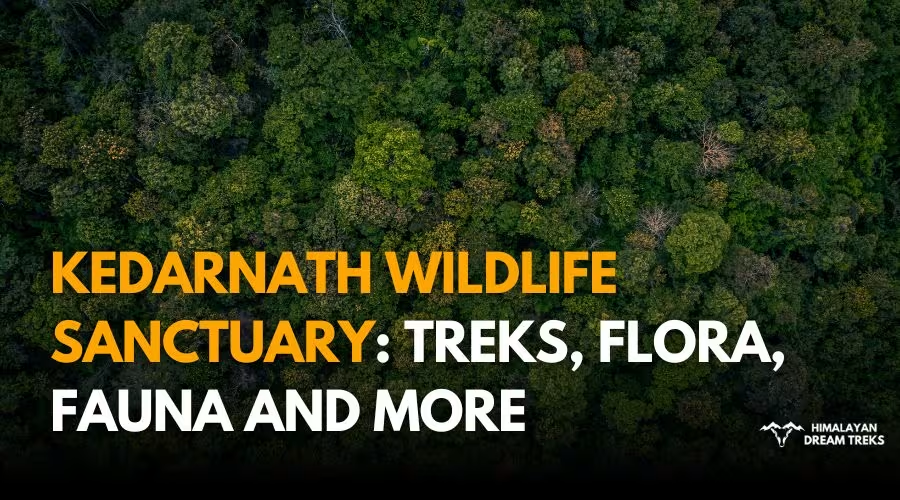
Leave a Comment